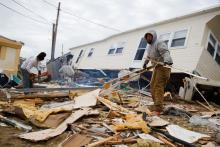Disaster Resistance and Resilience
Although often used interchangeably, within the building profession, disaster resistance refers to the ability to resist the onset and impact of a disaster, and disaster resilience refers to the ability to absorb the impact of a disaster. This module will provide information on how building science can help ensure that buildings remain standing during disasters while being energy efficient.
Curriculum
-
Remember
- List the four fundamental principles of resistance for all-hazard building design.
- List the three key features of resilience in infrastructures.
: Disaster Resistance and Resiliency - Level 1Lecture Notes
: Defining RobustnessProblem Set
: Fundamental Principles of Building ResistanceProblem Set
-
Understand
- Explain how the four key principles of building resistance and the three key features of infrastructure resilience are applied to protect buildings from disasters.
- Explain why building codes and industry standards are at the core of (essential to) effective disaster resistant and resilient building.
: Disaster Resistance and Resiliency - Level 2Lecture Notes
: Codes Helping Buildings Prepare for Natural DisastersProblem Set
: Understanding RobustnessProblem Set
-
Apply
- Identify and explain the role of 3 building-related stakeholders that are affected in a natural disaster.
- Applying relevant building codes, demonstrate in writing how a residential building meets resistance and resiliency specifications for one type of natural disaster for your climate zone and local area.
: Disaster Resistance and Resiliency - Level 3Lecture Notes
: Building StakeholdersProblem Set
: Example Building RequirementsProblem Set
-
Analyze
- Analyze and then provide specific examples in writing to demonstrate how applied building science has been used to make buildings more disaster resistant and resilient than traditional building practices.
- Analyze and summarize in writing with one specific example how disaster resistant and resilient design can also be energy-efficient design, and as a result, cost efficient over time.
: Disaster Resistance and Resiliency - Level 4Lecture Notes
: Designing Resilient and Cost Effective BuildingsProblem Set
: ICF Wall TypesProblem Set
Teaching Materials
Image
Image
Image
Image
Image
Handout
Image
Website
Image
Book
Image
Book
